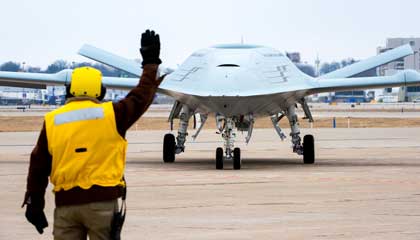
FILE PHOTO: Boeing conducts MQ-25 deck handling demonstration at its facility in St. Louis, Mo. Photo by Eric Shindelbower.
Navy announces release of MQ-25A home basing final Environmental Assessment and Finding of No Significant Impact
3/17/2021
The Navy has released a final Environmental Assessment (EA) and Finding of No Significant Impact (FONSI) for home basing of the MQ-25A Stingray carrier-based Unmanned Air System (Stingray CBUAS) at Naval Base Ventura County (NBVC) Point Mugu, California.
The Proposed Action is to establish facilities and functions at NBVC Point Mugu, California, to support home basing and operations of the MQ-25A Stingray CBUAS. Under the Proposed Action, the Navy would home base 20 Stingray CBUAS; construct a hangar, training facilities, and supporting infrastructure; perform air vehicle maintenance; provide training for operators and maintainers; conduct approximately 960 Stingray CBUAS annual flight operations; and station approximately 730 personnel, plus their family members.
The Stingray will enhance aircraft carrier capability and versatility through the integration of a persistent, sea-based, multi-mission aerial refueling and intelligence, surveillance, and reconnaissance unmanned aerial system into the carrier air wing. The Stingray will extend the range and reach of carrier air wings on the West Coast to meet current and future threats and enhance refueling and intelligence, surveillance, and reconnaissance capabilities in support of national defense objectives and policies.
Based on analysis presented in the EA, which has been prepared in accordance with the requirements of the National Environmental Policy Act, and in consultation with the U.S. Fish and Wildlife Service and California Coastal Commission, the Navy finds that implementation of the Proposed Action will not significantly impact the quality of the human environment. Therefore, an environmental impact statement is not required.
The EA prepared by the Navy is on file and interested parties may obtain a copy by downloading the EA from the project website: https://www.nepa.navy.mil/stingray. Electronic copies of this EA and Finding of No Significant Impact may also be obtained by written request to:
Naval Facilities Engineering Systems Command, Atlantic
(ATTENTION: Code EV21JB)
6506 Hampton Boulevard
Norfolk, Virginia 23508
The documents are also available for review at the Ray D. Prueter Library, 510 Park Avenue, Port Hueneme, CA and the E.P. Foster Library, 651 E. Main St, Ventura, CA.
MQ-25A Stingray Fact Sheet
Description
The MQ-25 system will deliver a robust organic refueling capability to make better use of our combat strike fighters and extend the range of our aircraft carriers. The system will be a critical part of the future CVW and will enhance carrier capability and versatility for the Joint Forces Commander through the integration of a persistent, sea-based aerial refueling Unmanned Aircraft System (UAS) into the CVW.
The Navy awarded an Engineering Manufacturing and Development contract to The Boeing Company in August 2018 to design, development, fabrication, test, delivery, and support of four MQ-25A unmanned air vehicles, including integration into the carrier air wing for an initial operational capability by 2024.
MQ-25 will be the first air system procured by the Navy's Unmanned Carrier Aviation Program Office. (PMA-268) It is comprised of three major architectural segments: an Air Segment (AS), a Control System & Connectivity (CS&C) Segment, and a Carrier (CVN) Segment.
AS Includes the MQ-25 UAS, which is composed of the MQ-25A Stingray air vehicle and associated support and handling equipment including the deck handling system, spares and repair materials.
CS&C Includes the Unmanned Carrier Aviation (UCA) Mission Control System (UMCS) and its associated communication equipment; the Distributed Common Ground Station-Navy (DCGS-N) mission support functionality; all network based interfaces and routing equipment required to control the Stingray; and all required modifications to existing networks and C4I system infrastructure.
CVN Composed of CVN ships spaces allocated to UCA as well as installed ship systems and modifications necessary for interface with the Air and CS&C segments. CVN systems important to the MQ-25 include aircraft launch and recovery systems, data dissemination systems (including radio terminals and antennas), and deck operations systems.
These segments are overseen by the Government Lead Systems Integrator (LSI), providing government-led system-of-systems integration for the Unmanned Carrier Aviation Program.
Background
Mission: The MQ-25 will enhance carrier capability and versatility for the Joint Forces Commander through rapid development, delivery, and integration of an effective, affordable, sustainable and adaptable unmanned air system into the Carrier Air Wing.
Military News | Navy News | DoD conditions-based reopenings


